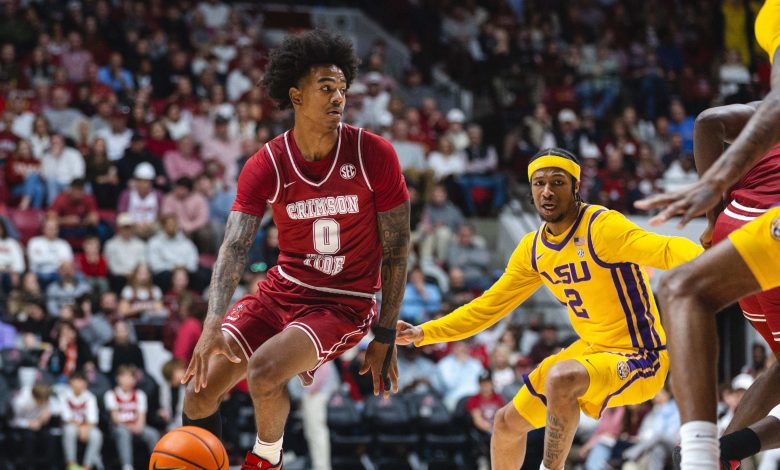In recent losses, Alabama basketball’s sluggish starts have caused strategic chaos.

Alabama basketball entered the 2023-2024 season with high expectations. After a strong finish the previous year, the Crimson Tide were projected to be one of the top teams in the SEC and a legitimate threat in the NCAA Tournament. With a talented roster filled with future NBA prospects and a head coach, Nate Oats, known for his fast-paced offense and defensive intensity, the Tide seemed poised for greatness. However, as the season has unfolded, a troubling pattern has emerged: sluggish starts that have often left Alabama scrambling in the second half. These early-game struggles have not only cost Alabama games but have also caused strategic chaos, forcing Coach Oats and his staff to constantly adjust on the fly, undermining their ability to play the style of basketball they excel at.
In a season where every game feels like a potential turning point, Alabama’s inability to start strong has become a crucial issue. Their early-game lapses have disrupted offensive flow, exacerbated defensive weaknesses, and resulted in significant turnover problems. This has forced the team to play catch-up against SEC opponents, many of whom are skilled at taking advantage of an opponent’s mistakes. The most recent losses, including those to Missouri and Arkansas, have further underscored how Alabama’s sluggish starts are not just a blip on the radar but a serious issue that could impact their aspirations in both the SEC and NCAA tournaments.
The Pattern: A Slow Start with Unsettling Trends
Alabama’s sluggish starts have taken on a distinct pattern over the past few weeks. The Crimson Tide have often struggled in the opening minutes of games, both offensively and defensively. On offense, they tend to be slow to settle into their rhythm, committing turnovers, missing open shots, and failing to execute their offensive sets. Defensively, the Tide have looked uncharacteristically disorganized, allowing easy baskets, struggling with defensive rotations, and showing a lack of urgency that is uncharacteristic of an Oats-led team.
Against Missouri, Alabama’s start was disastrous. The Tigers came out of the gate hot, jumping to an early lead while Alabama floundered with missed shots and careless turnovers. Missouri’s defensive pressure seemed to fluster Alabama’s offense, forcing the Tide into bad decisions, rushed shots, and turnovers. By the time Alabama managed to settle into the game, they were already playing from behind. The first half was marked by Alabama’s inability to establish any offensive rhythm, and the second half was spent in a frantic effort to overcome the deficit.
In their loss to Arkansas, the story was much the same. Alabama fell behind early, unable to handle the Razorbacks’ full-court pressure and defensive schemes. Their offense looked disjointed, with players unable to get into a groove, and the team was constantly playing catch-up. Once again, turnovers plagued the Tide, and while they made a late push in the second half, it was too little, too late. The sluggish starts not only put Alabama at a disadvantage but also forced them to abandon their preferred fast-paced, high-pressure style of play in favor of making up ground in a hurry.
The Impact on Offensive Flow
One of the hallmarks of Alabama basketball under Coach Oats has been their explosive, up-tempo offense. The Tide thrive when they can push the ball in transition, create open looks from beyond the arc, and move the ball quickly to break down defenses. However, these offensive strengths have been stymied by the slow starts in recent losses. Early-game turnovers, missed shots, and poor ball movement have completely disrupted their offensive rhythm.
In the first half of both the Missouri and Arkansas games, Alabama’s offense was stagnant and inefficient. Against Missouri, the Crimson Tide shot poorly from the field, particularly from three-point range, where they are usually deadly. Alabama finished the first half against the Tigers shooting just 36% from the field and 28% from beyond the arc. The lack of offensive efficiency meant that Alabama couldn’t get out in transition, which is when they are at their best. Instead of creating fast-break opportunities and getting easy buckets, they were forced into half-court sets where their offense looked uncharacteristic and out of sync.
Against Arkansas, the struggles were similar. Alabama’s ball movement was sluggish, and they couldn’t generate the quick ball reversals and open three-point looks they had been accustomed to. They were also unable to get the ball inside to their bigs, a strategy that had worked well in previous games. The early-game offensive struggles led to frustration, and by the time the Tide found their rhythm late in the game, it was clear they had already dug themselves a hole that was nearly impossible to climb out of.
Alabama’s issues on offense aren’t just about shooting. The turnovers and miscommunication on the offensive end have led to breakdowns in the Tide’s offensive sets. This has forced them into difficult, contested shots and has significantly lowered their field-goal percentage. Moreover, the frustration with the offense has often spilled over into Alabama’s defensive play, further exacerbating their sluggish starts. When shots aren’t falling, it’s difficult to stay mentally locked in on the defensive end, and Alabama has shown an increasing tendency to allow easy points after missed offensive possessions.
Turnovers: A Major Culprit
Perhaps the most glaring issue during Alabama’s sluggish starts is their turnover problem. Turnovers have been a persistent issue for the Crimson Tide this season, but in their recent losses, they have become a critical factor in their struggles. Against Missouri, Alabama committed 18 turnovers, many of which were unforced or the result of poor decision-making under pressure. Turnovers have become a strategic chaos for Alabama, as they disrupt the flow of the game, give the opposing team easy points, and force the Tide to play from behind.
In fast-paced games like those played under Oats, turnovers are a killer. Alabama relies on creating turnovers to fuel their offense, but when they are the ones turning the ball over, it completely undermines their strategy. The inability to secure the ball and make smart decisions in transition has led to missed opportunities and easy baskets for opponents. Against Missouri, for example, the Tigers capitalized on every turnover, converting them into fast-break points that allowed them to build a commanding lead. By the time Alabama found any rhythm, Missouri had already established a cushion that the Tide could not overcome.
In the loss to Arkansas, the Razorbacks played a physical, aggressive style of defense that Alabama was unprepared for. The Tide struggled to handle the pressure, particularly from Arkansas’ guards, and turnovers were a direct result of being flustered under the Razorbacks’ defensive schemes. As in the Missouri game, the turnovers allowed Arkansas to gain confidence and build an early lead, leaving Alabama to play catch-up for the rest of the game.
The turnover issue isn’t just about bad ball-handling—it’s also a matter of poor decision-making. Alabama’s players have often tried to force plays that aren’t there, resulting in turnovers that could have been avoided. Whether it’s an ill-advised pass, a rushed shot, or a misread defensive set, these turnovers have led to chaos on both ends of the floor and have made it difficult for Alabama to execute their strategy effectively.
Defensive Struggles and Lack of Focus
While Alabama’s offense has been stifled by slow starts and turnovers, their defense has also suffered in recent losses. One of the reasons for Alabama’s success earlier in the season was their ability to get stops on the defensive end and turn them into fast-break opportunities. However, in their recent games, the Tide have struggled defensively in the early stages, allowing opponents to dictate the pace of the game.
Against Missouri, Alabama’s defense was often caught out of position, and they failed to get back in transition after turnovers. The Tigers were able to score easy buckets in transition, and Alabama’s half-court defense struggled to contain Missouri’s shooters. The Crimson Tide also allowed too many second-chance points and failed to close out on three-point shooters, which allowed Missouri to build an early lead.
The Arkansas game was no different. Alabama’s defense, which had been a strength earlier in the season, was exposed by the Razorbacks’ aggressive style of play. Arkansas used ball movement and quick cuts to get easy baskets, and when Alabama’s defense collapsed, the Razorbacks capitalized on open shots. Alabama’s inability to make defensive adjustments quickly contributed to their slow start and inability to recover once they fell behind.
The Strategic Chaos: Coach Oats’ Adjustments
The slow starts and turnovers have thrown Alabama into a state of strategic chaos. When the Crimson Tide fail to execute their game plan early, Coach Nate Oats is forced to make adjustments on the fly, often with limited success. Alabama’s preferred style of play—up-tempo and aggressive—requires that the team be disciplined on both ends of the floor. However, when the Tide are caught in a hole early due to turnovers and poor shot selection, Oats is left to make emergency adjustments to get his team back on track.
One of the key adjustments Oats has tried is shifting to a more half-court offense when the fast-break opportunities aren’t there. This has worked at times, but it isn’t the Crimson Tide’s strength, and they often look out of sync when forced into that style of play. Additionally, Oats has tried to mix up the defensive schemes, but the lack of focus and discipline has undermined these efforts. Alabama’s defensive rotations often break down when they are playing from behind, and this only adds to the pressure on their offense to score quickly.
As the losses pile up, the question becomes whether Coach Oats can adjust to the persistent early-game struggles. His ability to make changes during the game is one of his strengths, but the early deficits leave his team scrambling to execute, and the constant pressure of coming from behind is mentally exhausting for a squad that is still trying to find its rhythm.
Looking Ahead: Is There Time for
Improvement?
The question now is whether Alabama has enough time to clean up their early-game struggles before it costs them too much in both the SEC and NCAA tournaments. The Crimson Tide have enough talent to make a deep run, but their inability to start games on the right foot could undermine their potential. Coach Oats will need to instill greater focus and discipline in his team, especially when it comes to ball security and defensive consistency. If the Tide continue to struggle in the opening minutes, they will find themselves in increasingly difficult situations, both in the conference race and in the postseason.
In conclusion, Alabama’s sluggish starts in recent losses have created a chaotic situation that has thrown off their offensive flow, caused strategic confusion, and undermined their defensive identity. While there is still time to address these issues, the Crimson Tide will need to find a way to start games with more intensity and focus if they hope to meet the high expectations set for them at the beginning of the season.









